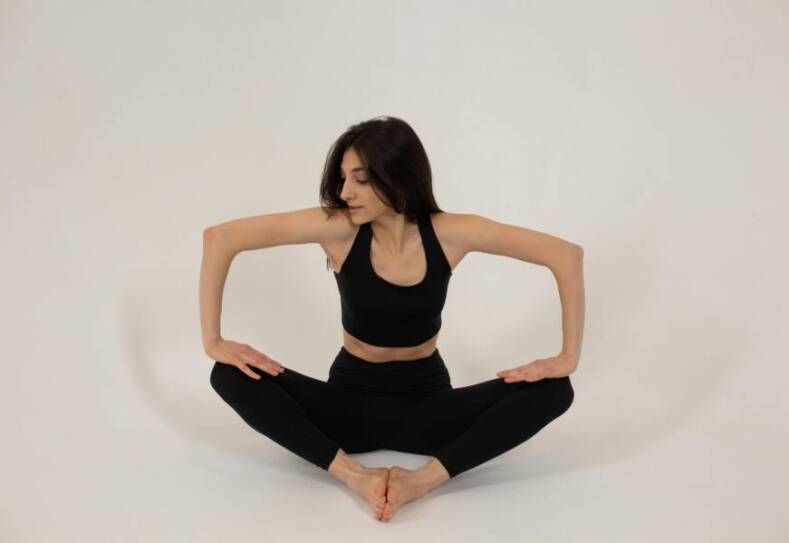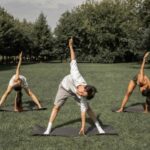Mobility stretches are essential for maintaining the functional range of motion in the hips. With lifestyles that often involve prolonged periods of sitting, the hip flexors, glutes, quadriceps, adductors, and hamstrings can become tight, restricting movement and leading to discomfort. Incorporating hip stretches into a regular routine can improve flexibility and reduce the risk of strain, facilitating fluid and pain-free movement.
Good hip mobility contributes to overall wellbeing and performance in physical activities. Exercises that target the hips can help to alleviate pain by loosening tight muscles and strengthening the surrounding areas to support the joint. It is not only athletes who benefit; anyone can experience improved circulation, enhanced coordination, and better posture from regular stretching.
To maximize the effectiveness of hip mobility stretches, they should be performed with correct form and for an appropriate duration. Sets of repetitions, typically ranging from 5 to 12, are advised to ensure the muscles are being sufficiently challenged. With consistency, these exercises can lead to noticeable improvements in hip flexibility and mobility, contributing to a healthier and more active lifestyle.
The Fundamentals of Hip Mobility
Essential hip mobility is achieved through a combination of understanding the specific anatomy involved and maintaining the flexibility necessary for healthy joint function.
Understanding Hip Anatomy
The hip is composed of a ball-and-socket joint, where the head of the femur (thigh bone) fits into the acetabulum of the pelvis. This design allows for a significant range of motion, including the ability to flex (bring the thigh closer to the abdomen) and extend (move the thigh away from the abdomen). Surrounding the joint are various hip muscles, including the hip flexors, which help control these movements. Each muscle plays a role in either stabilizing or mobilizing the hip.
The Importance of Hip Flexibility
Maintaining hip flexibility is critical for joint mobility. Without regular stretching and movement, the muscles around the hip, particularly the hip flexors, can become tight, restricting the hip’s ability to move and potentially leading to pain and reduced range of motion. Consistent stretching not only lengthens the muscles, allowing them to reach their functional potential but is also vital for overall hip health.
Common Causes of Hip Tightness
Hip tightness can stem from various lifestyle and physical factors. This section delves into how a sedentary lifestyle and certain physical activities contribute to this discomfort.
Consequences of Sedentary Lifestyle
Long periods of sitting can lead to tight hips. When individuals remain seated for excessive durations, the hip flexors can shorten and become stiff, often resulting in pain and reduced mobility. This issue is particularly prevalent in office workers and individuals who spend a large proportion of their day at a desk.
- Result of excessive sitting: Shortened hip flexors and potential chronic discomfort.
Impact of Physical Activities
Physical activities, especially those involving repetitive motion or inadequate stretching, can also be a culprit. High-intensity sports or exercises that heavily rely on the hip muscles, without proper cool-down stretches, might lead to hip tightness. Athletes who perform high kicks, sprints, or engage in activities like cycling may be notably susceptible.
- Activities that can contribute to tight hips: Running, martial arts, dance, and cycling.
- Prevention: Incorporating cool-down stretches to maintain hip flexibility.
Assessment of Hip Mobility
Evaluating hip mobility involves understanding its range of motion and recognizing when specialist intervention is necessary. A comprehensive assessment can help identify the degree of flexibility and pinpoint any concerns that may need attention from a physical therapist or doctor.
When to Consult a Physical Therapist
Individuals should consult a physical therapist (DPT) if they experience limited range of motion in the hips, persistent discomfort, or difficulty performing daily activities. A physical therapist is equipped with the expertise to assess hip mobility through various clinical tests and can formulate a personalized plan to address any deficiencies. They can determine if the mobility issues stem from muscle tightness, joint stiffness, or other underlying conditions.
Key signs that warrant a professional assessment include:
- Difficulty in movements that used to be easy
- Pain during exercises targeting the hip area
- Noticeable asymmetry in hip motion compared to both sides
In contrast, individuals may not need to see a physical therapist if they have full range of motion and can perform hip mobility exercises without discomfort. Regularly assessing hip mobility can help maintain good hip health and function.
Key Hip Mobility Exercises
Incorporating hip mobility exercises is essential for maintaining the range of motion and strengthening the muscles around the hip joint. They target key areas such as hip flexors, glutes, and adductors to improve flexibility and function.
Hip Flexor Workouts
Hip Flexor Stretch: This movement is crucial for those who spend long periods sitting, as it helps to alleviate tightness in the hip flexors. One effective stretch is the kneeling hip flexor stretch:
- Begin in a lunge position with the rear knee on the ground.
- Engage the glutes and gently push the hips forward until a stretch is felt in the front of the hip.
- Hold for 20-30 seconds and switch sides.
Straight Leg Raise: This exercise strengthens the hip flexors and can be performed without equipment:
- Lie on the back, legs straight and arms at the sides.
- Raise one leg, keeping it straight, until it is about 45 degrees from the floor.
- Lower slowly and repeat for 10-12 repetitions before switching legs.
Glute Strengthening Movements
Glute Bridges: Glute strength is key for hip stability and overall lower body health.
- Lie flat on the back with knees bent and feet flat on the floor.
- Lift the hips toward the ceiling while squeezing the glutes, then lower back down.
- Perform 2-3 sets of 10-15 repetitions.
Pigeon Pose: Originally from yoga, Pigeon Pose targets both hip flexors and glutes.
- Start in a downward-facing dog position, then bring the right knee forward to the right wrist.
- Extend the left leg back, keeping the hips square to the floor.
- Hold for 30 seconds to 1 minute then switch sides.
Adductor Opening Moves
Butterfly Stretch: A popular move for opening the adductors—
- Sit with the soles of the feet together and knees dropped to the sides.
- Gently press the knees down with the elbows or apply downward pressure for a deeper stretch.
- Hold for 30 seconds to 1 minute.
Adductor Stretch: Specifically aiming the inner thigh muscles, this stretch can aid in improving hip mobility:
- Stand with feet wider than shoulder-width apart, toes pointing slightly outwards.
- Shift bodyweight to one side, bending one knee while the other leg stays straight.
- Hold the stretch for 20-30 seconds and repeat on the opposite side.
Each of these exercises can enhance hip mobility and contribute to a balanced fitness routine. Consistency and proper form are key for the best results and to avoid injury.
How to Improve Hip Flexibility
Hip flexibility is crucial for maintaining a wide range of motion and enhancing circulation. By incorporating both dynamic and static stretches into one’s routine, an individual can significantly improve their mobility training outcomes.
Dynamic Stretching Techniques
Dynamic stretches involve movement as they prepare the muscles for action, improve flexibility, and increase blood flow. These stretches are best performed as part of a warm-up routine before engaging in physical activity.
- Leg Swings: Stand on one foot, swinging the other leg forward and backward, gradually increasing the range with each swing.
- Lunges with a Twist: Perform a standard lunge, adding an upper body twist towards the front leg to dynamically stretch the hip flexors.
Static Stretching Routines
Static stretches require holding a position for a period, typically between 15-30 seconds, to elongate the muscle fibers after physical activity, thereby promoting flexibility and reducing muscle tension.
- Pigeon Pose: In a seated position, bend one leg in front of the body while extending the other behind, leaning forward to deepen the stretch in the hip of the front leg.
- Butterfly Stretch: Sitting down, press the soles of the feet together and gently push down on the knees with the elbows to stretch the inner thighs and hips.
Integrating Hip Mobility into Daily Life
Improving hip mobility can significantly enhance one’s overall movement and reduce stiffness. By incorporating hip mobility exercises into routine activities and regular workouts, individuals can maintain healthy hip function and contribute to joint longevity.
Routine Activities
One can improve hip mobility through small, consistent changes in daily activities. For example, when sitting for long periods, setting an hourly reminder to stand and perform a series of hip rotations can mitigate tightness. This involves standing with feet shoulder-width apart and gently rotating the torso while keeping the knees soft. Integrating movements such as squatting to pick up items from the ground instead of bending at the waist engages the hips more effectively.
Exercise Incorporation
During physical activity, adding hip mobility stretches before and after a workout can greatly benefit hip joints. Start workouts with dynamic movements like leg swings, which prepare the hips for subsequent exertion. At the conclusion of a workout, dedicate time to static stretches, such as the lunging hip flexor stretch, which involves stepping one foot forward into a lunge position, knee over ankle, and sinking the hips forward to feel a stretch in the front of the back leg’s hip. These practices can be easily incorporated into most exercise routines and support hip health.
Addressing Hip Pain and Injuries
Addressing hip pain requires a multifaceted approach that begins with preventative strategies to maintain hip health and includes rehabilitative measures once injuries or discomfort arise. These approaches focus on alleviating pain, reducing tightness, enhancing stability, and may be beneficial for conditions such as arthritis and back pain.
Preventative Strategies
Preventative measures for hip health emphasize maintaining a balance between flexibility and strength to ensure stability and avoid undue stress on the hip joint. Highly recommended strategies include:
- Regular Stretching: Incorporate hip flexor, hamstring, and quadriceps stretches to maintain flexibility and prevent tightness.
- Strengthening Exercises: Focus on exercises like bridges and leg raises to build strength around the hips, providing better support and reducing the risk of injuries.
- Posture Awareness: Proper posture while sitting, standing, and moving can prevent abnormal loading of the hip joint and may alleviate back pain.
- Activity Modification: Modifying activities that exacerbate hip pain or inflammation is crucial. For example, cycling or swimming can be less impactful on the hips compared to running.
Rehabilitative Measures
When hip pain or injuries occur, rehabilitative measures aim to restore mobility and relieve discomfort. It is important to consult a healthcare professional for an accurate diagnosis and tailored treatment plan. Rehabilitation may include:
- Physical Therapy: A physical therapist can assess and provide a series of targeted exercises to improve range of motion and strength.
- Heat and Cold Therapy: Applying heat can help relieve muscle tightness, while cold therapy may reduce inflammation and pain.
- Anti-Inflammatory Medications: Non-steroidal anti-inflammatory drugs (NSAIDs) can be utilized to manage pain and inflammation in the short term.
- Assistive Devices: For those with significant pain or stability issues, canes or walkers may be recommended to reduce pressure on the hips.
It is essential for individuals to engage in these strategies regularly and make them part of a comprehensive approach to hip health.
Advanced Hip Mobility Drills
Incorporating advanced hip mobility drills into a training regimen can enhance joint flexibility, reduce stiffness, and prevent injuries like hip impingement. Athletes looking to refine their performance will find sport-specific training and progressive overload techniques crucial for optimizing hip mobility.
Sport-Specific Training
Athletes should consider the unique demands of their sport when choosing hip mobility drills. For instance, a sprinter might focus on dynamic stretches that mimic running mechanics, thereby improving hip flexor responsiveness.
- Squats: Deep squats can promote hip joint flexibility while also strengthening the knee joints. For sprinters, squat speed and depth should be varied to simulate the action of sprinting.
- Deadlifts: This compound lift supports hip and knee stability. Athletes may perform variations such as the single-leg deadlift to mimic the balance and coordination required in many sports.
Progressive Overload Techniques
Progressive overload is essential for advancing hip mobility. Gradually increasing the range of motion or complexity of exercises ensures continuous improvement.
- Bulgarian Split Squat: By elevating the rear leg, this exercise places greater emphasis on the hip of the working leg, and with progressive overload, can lead to enhanced mobility and stability.
- Exercising With Bands: Incorporating resistance bands into hip mobility drills can add tension, forcing the muscles to adapt and become more flexible.
When athletes engage in advanced drills, they should always maintain a focus on form to prevent strain on the hips and surrounding muscles. Regular hip mobility work is fundamental for a well-rounded physical conditioning program, allowing for smoother movements during both exercising and everyday activities.








